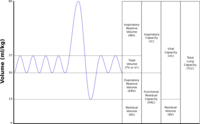
Photo from wikipedia
Abstract The partial pressure of oxygen decreases as altitude increases, the preoperative chronic hypoxemia (CH) may have a plausible clinical impact. Risk factors for postoperative serious adverse events (pSAEs) in… Click to show full abstract
Abstract The partial pressure of oxygen decreases as altitude increases, the preoperative chronic hypoxemia (CH) may have a plausible clinical impact. Risk factors for postoperative serious adverse events (pSAEs) in patients living in high altitudes during primary hip arthroplasty (HA) are not clear. This is an observational study embracing patients from January 1, 2011 to December 31, 2015 at Yan’an Hospital of Kunming City, a 1338-bed municipal teaching hospital of Kunming Medical University. Univariate analysis revealed that significant differences between patients with and without preoperative CH occurred in intraoperative hypotension (77 [33%] vs 34 [47%], P = .040) and that significant differences between patients with and without pSAEs occurred in following variables: preoperative CH (32 [57%] vs 199 [80%], P < .001), intraoperative hypotension (37 [66%] vs 74 [30%], P < .001), highest noradrenaline support (.09 [.01–.21] vs .03 [.01–.05] &mgr;g/kg/min, P < .001), higher application of general anesthesia (15 [27%] vs 29 [12%], P = .004), and lower of combined-spinal epidural anesthesia (CSEA) (21 [37%] vs 165 [66%], P < .001). The general anesthesia and intraoperative hypotension remained the independent risk factors for pSAEs (P < .05), while the preoperative CH presented by decreasing its risk (P < .05). This study suggests that various intraoperative events including general anesthesia, hypotension were risk factors for the development of pSAEs. Preoperative CH, presenting with decreased incidence of intensive care unit (ICU) admission and pSAEs, may mimic hypoxic preconditioning in organic protection, for which further study is needed to uncover the underlying mechanisms.
Journal Title: Medicine
Year Published: 2017
Link to full text (if available)
Share on Social Media: Sign Up to like & get
recommendations!